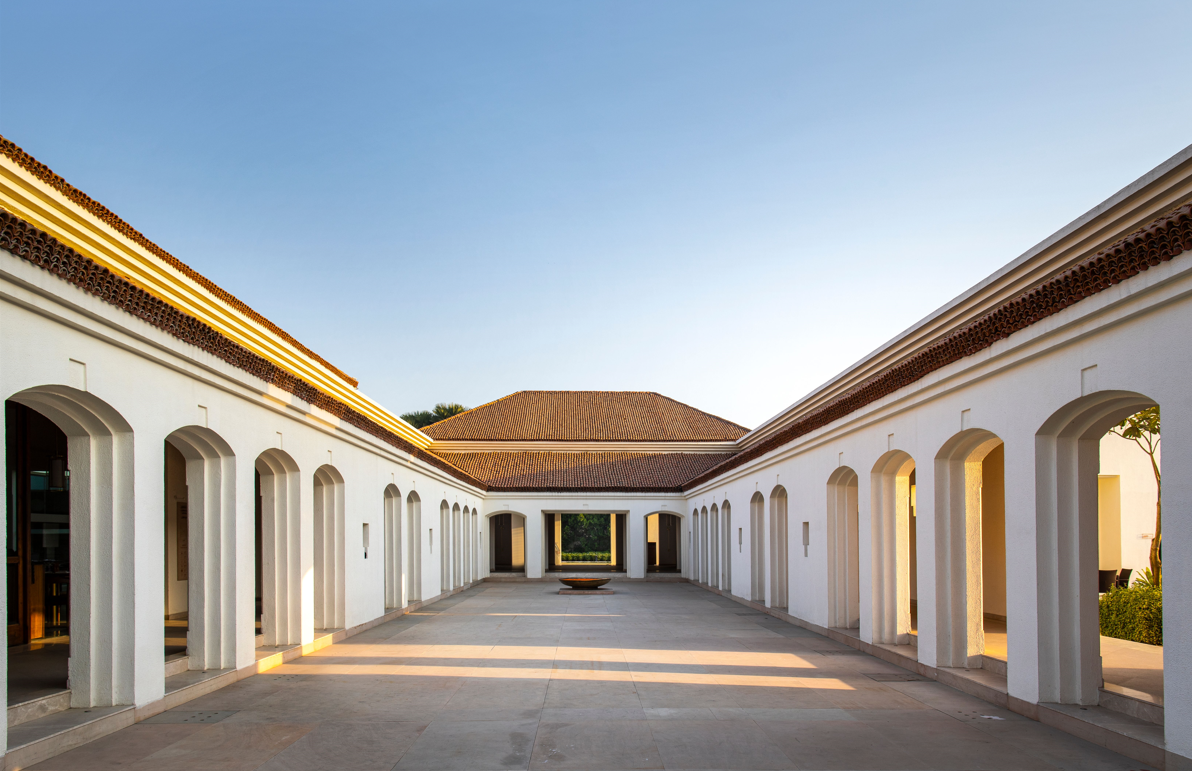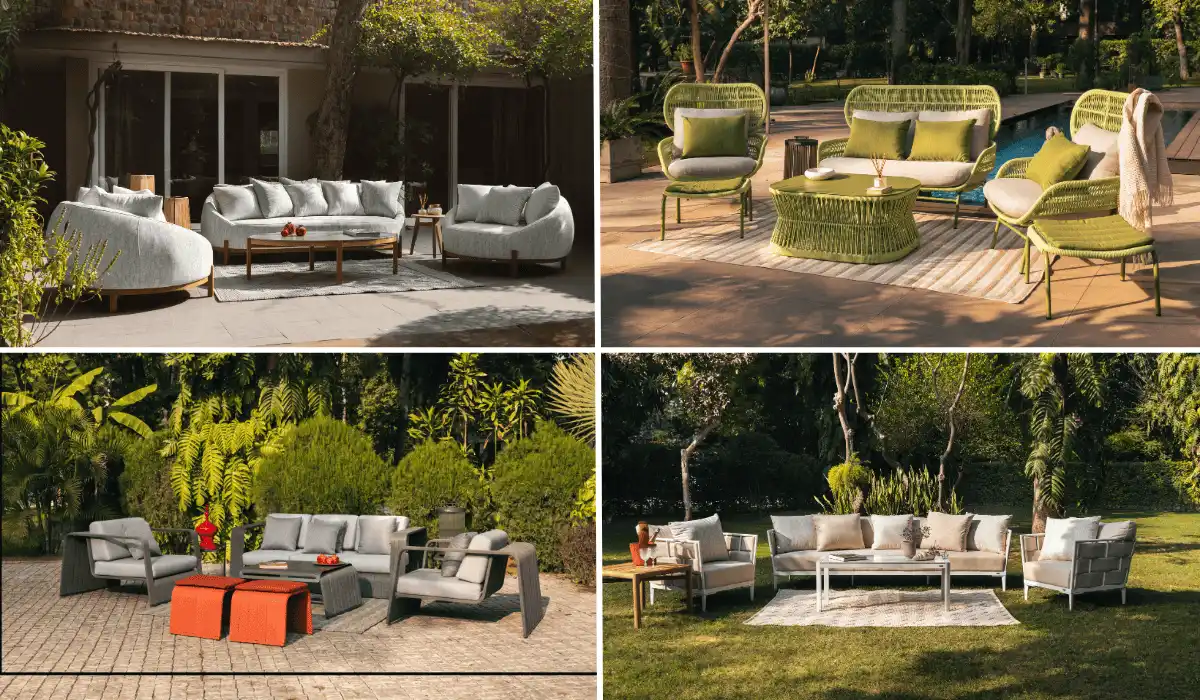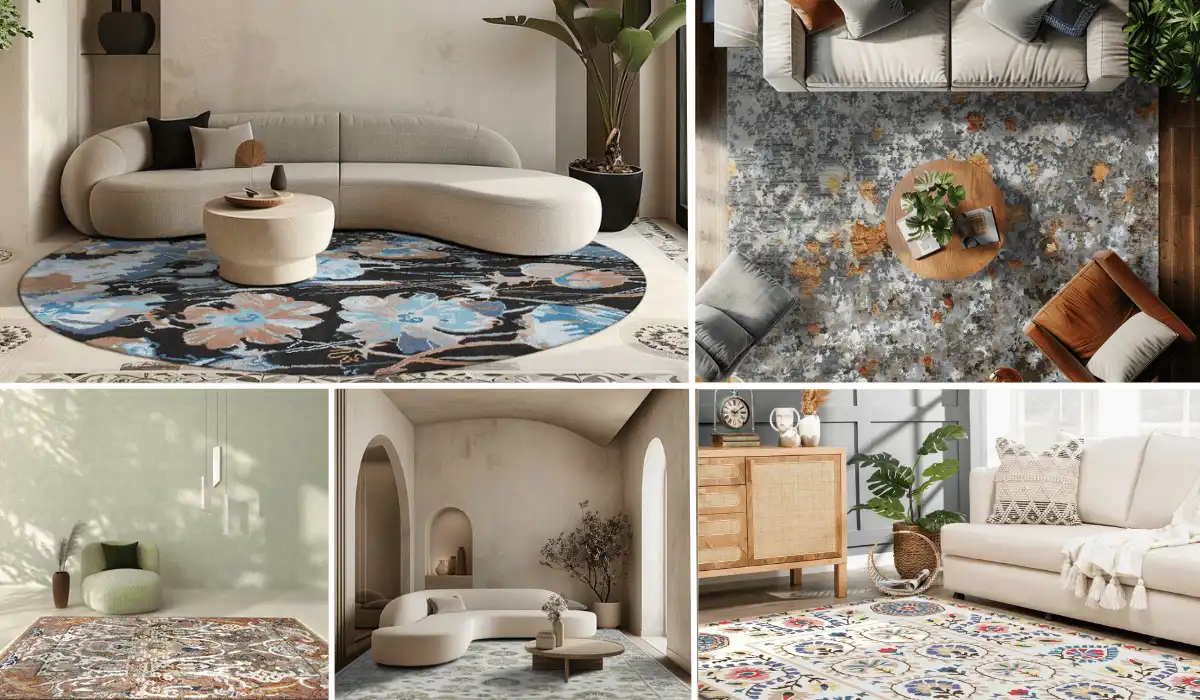Designed to serve tourists in the holiest city for Buddhists, the Hotel in Bodh Gaya Uses the Power of Memory and Emotion to Create Immersive architecture that Embodies the Tenets of Buddhism.
Bodh Gaya, where Lord Buddha is deemed to have received enlightenment, is one of the holiest and oldest pilgrimage sites for Buddhists. Hundreds of thousands of pilgrims and tourists from around the globe visit the city annually. Spread over 5-acres, not far from the Mahabodhi Temple (one of the four holy sites related to the life of Lord Buddha), the Hotel in Bodh Gaya responds to the religious tourism in the region–designed as an ode to the historical roots of Buddhism in India.

The 78-key hotel consists of two key zones–the public block closer to the Northern access road and the guest block on the site’s Southern end. All vehicular movement is restricted to the site periphery. The public block has spaces arranged around a long, central courtyard, which forms the physical and emotional heart of the hotel. This zone comprises a reception, banqueting facilities, a health center with a spa, a gym, a swimming pool, and a restaurant. A linear waterbody oriented east-west separates this public zone from the residential block comprising guest rooms and suites.

Invoking Memory and Emotion
Each space in Hotel Bodh Gaya represents the tenets of Buddhism through two key architectural lyrics–memory and emotion. The first one–memory–is invoked through traditional features of Buddhist architecture. Vaults, corbelled arches, and stepped jambs are re-envisioned in a contemporary idiom across all spaces in the hotel–reminiscent of the past but designed for the present.
The other architectural lyric of emotion conveys the Buddhist ethos of simplicity, compassion serenity through a series of gestures. In that spirit, a series of layers from outside to inside in the form of outdoor, semi-outdoor, and indoor spaces allow for a gentle transition into the public spaces as one enters the public block. Portals are formed at the edges of these transitional spaces. Viewing spaces through these frames is like viewing the passage of life and its different phases. A banyan tree, the same tree species under which the Buddha is said to have received enlightenment, sits at the other end of the central courtyard, which is seen through these frames–signifying Buddhism’s ultimate goal of enlightenment. The building embraces the human scale, which is conveyed through the proportions of the courtyards, verandahs, arches, and windows. The soothing color palette of muted whites and warm terracotta further lends to the lyric of emotion.


The landscaping of exterior spaces, including the linear, river-like water body with floating lotus plants (associated with the purity of body, speech, and mind in Buddhism) gives rise to calmness and tranquillity. Edged by ghat-like steps (ceremonial stairway to a river), the water body allows visitors to rest and rejuvenate in the outdoors.


Buddhist Philosophy and Symbology as a Tool for Wayfinding
Ideas from Buddhist philosophy and symbology are translated into the Bodh Gaya hotel’s interiors, artwork, and signage, which also ease navigation. The five pearls of wisdom associated with Buddhism represented in the Buddhist icon of Vajradhatu Mandala, are expressed in the five public spaces–reception, cafe, banquet, lounge, and spa-gym-pool. These wisdom are fearlessness, the wisdom of dharma, giving and sharing, unity with oneself, and oneness with the earth. The mandala associates each wisdom with a mudra (a symbolic hand gesture). Each mudra is further associated with specific colors, seasons, elements, and symbols, which are translated into interior design schemes for the spaces.

For instance, the spa-gym-pool, which represents the wisdom of ‘oneness with the earth’, is associated with the color blue–which has been used in all the internal walls of the space. The wisdom’s connection to the winter season is represented through the motif of a bare tree on one wall, and its link to the symbol of the vajra (a ritual object extensively employed in Tibetan Buddhist ceremonies), is represented by a wall pattern derived from an abstraction of the symbol. Finally, the wisdom’s association with water is conveyed through the swimming pool, and an abstract motif denoting the element of water, which is used in the signage for the space
To Brick or Not to Brick
The romance of working with brick, widely used in Bodh Gaya’s local and traditional architecture, was immense. However, the architects found that sandy soil on the site with a poor bearing capacity made brick foundations prohibitive. Furthermore, brick vaults are not accepted in the Indian Standard Codes for earthquake resistance. Studies conducted also suggested autoclaved Aerated Concrete (AAC) blocks would insulate the interiors 1.5 times better than Brick, thus saving costs and energy in the long run. Ultimately a combination of materials was chosen for Hotel Bodh Gaya. These comprise–RCC, local brick and AAC blocks for the structure, and terracotta-tinted concrete for the vaults–each material doing what is best for the project.

Collaborating with the Local Community
Hotel Bodh Gaya uses locally-made roof tiles with an earthy, crafted visual appeal to them as the last layer of insulation over the RCC vault roof–a conscious choice born out of the opportunity and need to support the local economy. These half-round clay tiles, often called ‘country tiles’, are almost invisible in other parts of India. The industry is based on part-time farm labor, as families use the earth from their fields and a potter’s wheel to create cylinders of clay that are then cut and fired into half-round tiles. The process, entirely intuitive and skill-based, relies on the potter’s sense of when the clay has been worked enough to take off the wheel. The architects collaborated with 26 local families in 12 villages near Bodh Gaya to handcraft 80,000 clay tiles, which insulate the vaulted ceilings–cheaper and far more sustainable than industrial insulation alternatives.


Passive Design Strategies to Regulate the Local Microclimate
Several passive design strategies are integrated into the design of Hotel Bodh Gaya to reduce energy consumption and create a thermally comfortable environment, particularly during Bodh Gaya’s hot and dry summers. The residential blocks are oriented in the north-south direction to minimize heat gain from the western facade during the summer months. Aerated concrete blocks, double-glazed windows, and a double roof system topped with clay tiles create a well-insulated envelope.

The double roof constitutes a concrete vault and a pitched roof covered with steel and clay tiles, with an air gap between them. This keeps indoor temperatures comfortable in all seasons, thus reducing energy consumption.
Channeling, Conserving, and Restoring Water
The hotel’s extensive water management system illustrates the Buddhist idea of mindfulness and conscious consumption. The site is located on a low-lying paddy field, in close proximity to the Falgu River. In the three months of monsoon, the river floods the regions in its vicinity. Therefore, the site has been raised to the same level as a nearby culvert that does not get submerged during monsoons.

In sharp contrast, the water in the river disappears during the summer. At this time, like many other parts of India, water availability becomes a challenge in Bodh Gaya–making it crucial to harvest rainwater on site. However, due to its sandy-silty soil, the region’s water percolation rates are exceedingly slow. Thus, to give the soil adequate time to soak in all the rainwater, several interventions are adopted to hold water while preventing flooding on site, and thus, any obstacles to the hotel’s operations are collected into some underground harvesting pits on site.
These deep pits with honeycombed walls hold the water until it seeps into the earth via openings in their walls and base.-
Rainwater is collected into several underground harvesting pits on site. These deep pits with honeycombed walls hold the water until it seeps into the earth via openings in their walls and base.
Rainwater from some roofs is collected in underground tanks for irrigation.
Bioswales have been integrated to allow water to seep into the earth as it flows through the site. The swales emulate natural streams supporting a host of plants that grow on both edges.
A pond has been created in the lowest portion of the site in the east; this pond can act as an emergency water holding area in case of a flash flood.


Biltrax Construction Data is tracking 26,000+ projects on their technology platform for their clients.
Get exclusive access to upcoming projects in India with actionable insights and gain a competitive advantage for your products in the Indian Construction Market.
Visit www.biltrax.com or email us at contact@biltrax.com to become a subscriber and generate leads.
Disclaimer: The information contained herein has been compiled or arrived at, based upon information obtained in good faith from sources believed to be reliable. All such information and opinions can be subject to change. The image featured in this article is for representation purposes only and does not in any way represent the project. If you wish the article to be removed or edited, please email editor@biltrax.com.
Discover more from Biltrax Media, A Biltrax Group venture
Subscribe to get the latest posts sent to your email.






















